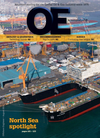
Page 120: of Offshore Engineer Magazine (Aug/Sep 2014)
Read this page in Pdf, Flash or Html5 edition of Aug/Sep 2014 Offshore Engineer Magazine
North Sea
What will it take to develop offshore heavy oil?
The Mariner heavy oil feld took 40 years, 12 oil companies, fve seismic surveys, and 18 exploration/appraisal wells to get to where it is today. Ingolf
Søreide explains how heavy oil production has improved and where it is still challenged. t’s mid-1977 and a geophysicist is analyzing 2D seismic data acquired in
I
UK Block 9/12. The survey happened to include some data from the neighbor- ing block. In this 9/11 Block data, the
The Mariner development geophysicist discovers a feature that is concept. Images from Statoil.
promising enough to persuade Union Oil management to acquire a license.
Plans to drill were quickly drawn and offtake unit (FSO) up and the semisubmersible Dixilyn to take the produced oil
Field 97 was chartered to evaluate the away. The development prospect. The frst well in 1981 hit oil. cost Statoil and partners
JX Nippon and DYAS in Unfortunately, the rig was also hit when a the production. In addition, energy is excess of US$7 billion. supply boat collided with it. After a visit required to lift the oil, since it is unable
So why did it take 40 to the shipyard, three more wells quickly to fow on its own. Wells are commonly years, 12 oil companies, followed, two of which tested promising equipped with expensive downhole fve seismic surveys, amounts of oil. The only problem was electrical submersible pumps. Working in and 18 exploration/ that it was heavy, 14° API, in fact. Not harsh downhole conditions, the pumps appraisal wells to reach like the light 38°-40° API found in Brent need regular maintenance and replace- this point? and Forties. ment using expensive rigs. Once the oil
The answer lies in the Both Union Oil and the company who is on surface, the challenges continue. heavy oil. These types did the original survey, Seismograph Separating heavy oil from water is diff- of reservoirs are typifed Service Ltd., are long gone. But Mariner, cult and water disposal is a challenge. As by low fow rates and the feld they helped fnd, held an esti- if that was not enough, the refners would early water break- mated two billion barrels of oil. rather take the light Brent, and heavy through, often within a Fast forward 40 years to 2017. A brand crudes often sell at a discount.
few months. Once water new six-leg platform has been installed in So what made the difference on does break through, it 110m of water. There are three modern Mariner? In one word, technology. completely dominates rigs on site and a large foating, storage Specifcally, the application of tools such
Mariner’s location in the UK North Sea. jacket in cooperation with the UK ofces of
Statoil’s Mariner development up close
Canada’s SNC Lavalin. Ofshore installa-
The development of the Mariner feld based on a steel jacket, with a foating tion of the platform jacket is scheduled will contribute more than 250MMbbl storage unit (FSU). The topsides are being for mid-2015, followed by topsides during reserves with average production of about fabricated by Daewoo Shipbuilding & 2016.
55,000bbl/d over the plateau period from Marine Engineering in Korea. The FSU is Drilling will be carried out from the PDQ 2017-2020. The expected date for produc- being built by Samsung Heavy Industries, drilling rig, with a jackup rig assisting for tion start is 2017. also in Korea. Spain’s Dragados Ofshore the frst 4-5 years. Statoil is planning to
The concept chosen includes a produc- was awarded an engineering, procurement use a new category J rig on Mariner, oper- tion, drilling and quarters (PDQ) platform, and construction contract for the steel ated by Noble Corp. The category J rigs
August 2014 | OE oedigital.com 122 122_OE0814_Geofocus6_Statoil.indd 122 7/23/14 2:58 AM

 119
119

 121
121